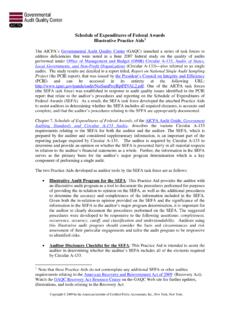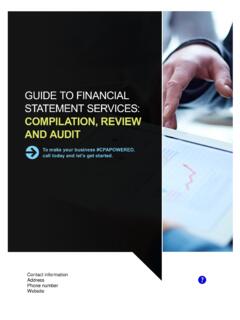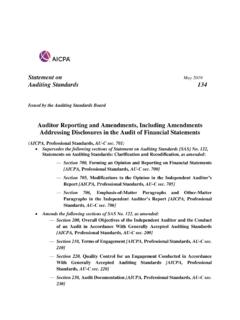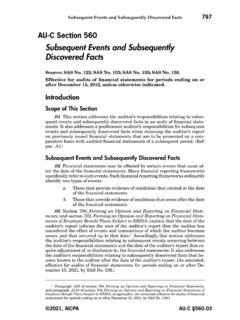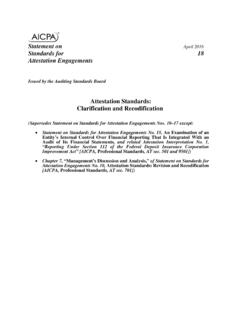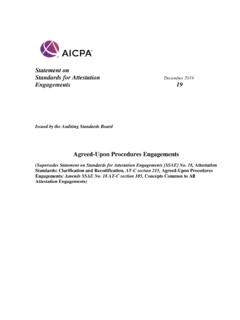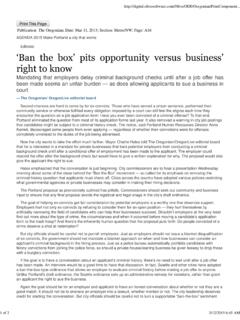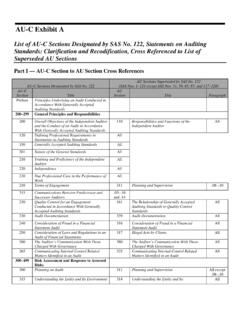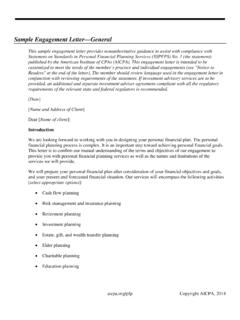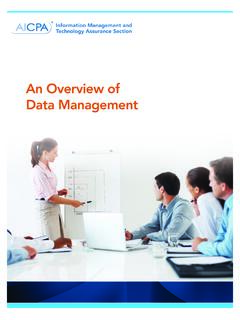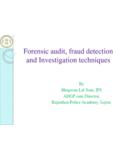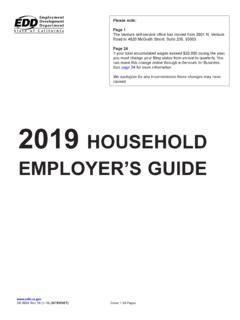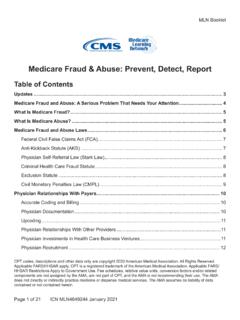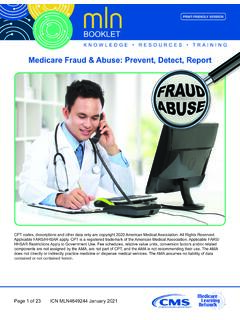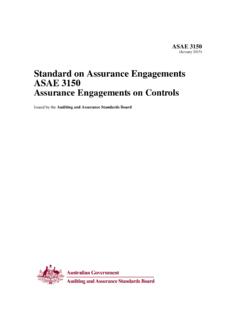Transcription of AU Section 316 - American Institute of Certified Public ...
1 Consideration of fraud in a Financial Statement Audit1719AU Section 316 Consideration of fraud in a FinancialStatement Audit(Supersedes SAS No. 82.)Source: SAS No. 99; SAS No. for audits of financial statements for periods beginning on or afterDecember 15, 2002, unless otherwise and 110,Responsibilities and Functions of the Independent Audi-tor, paragraph .02, states, "The auditor has a responsibility to plan and performthe audit to obtain reasonable assurance about whether the financial state-ments are free of material misstatement, whether caused by error or fraud .[footnote omitted]"1 This Section establishes standards and provides guidanceto auditors in fulfilling that responsibility, as it relates to fraud , in an audit offinancial statements conducted in accordance with generally accepted auditingstandards (GAAS).
2 Following is an overview of the organization and content of thissection: Description and characteristics of Section describes fraudand its characteristics. (See paragraphs .05 through .12.) The importance of exercising professional Section dis-cusses the need for auditors to exercise professional skepticism whenconsidering the possibility that a material misstatement due to fraudcould be present. (See paragraph .13.) Discussion among engagement personnel regarding the risks of mate-rial misstatement due to Section requires, as part of plan-ning the audit, that there be a discussion among the audit team mem-bers to consider how and where the entity's financial statements mightbe susceptible to material misstatement due to fraud and to reinforcethe importance of adopting an appropriate mindset of professionalskepticism.
3 (See paragraphs .14 through .18.)1 The auditor's consideration of illegal acts and responsibility for detecting misstatements result-ing from illegal acts is defined in Section 317,Illegal Acts by Clients. For those illegal acts that aredefined in that Section as having a direct and material effect on the determination of financial state-ment amounts, the auditor's responsibility to detect misstatements resulting from such illegal acts isthe same as that for errors (see Section 312,Audit Risk and Materiality in Conducting an Audit,orfraud).2 Auditors are sometimes requested to perform other services related to fraud detection and pre-vention, for example, special investigations to determine the extent of a suspected or detected other services usually include procedures that extend beyond or are different from the proce-dures ordinarily performed in an audit of financial statements in accordance with generally acceptedauditing standards (GAAS).
4 AT Section 101,Attest Engagements, and CS Section 100,Consulting Ser-vices: Definitions and Standards, provide guidance to accountants relating to the performance of Standards of Field Work Obtaining the information needed to identify risks of material mis-statement due to Section requires the auditor to gatherinformation necessary to identify risks of material misstatement dueto fraud , of management and others within the entity about therisks of fraud . (See paragraphs .20 through .27.) the results of the analytical procedures performed inplanning the audit. (See paragraphs .28 through .30.) fraud risk factors. (See paragraphs.)
5 31 through .33,and the Appendix, "Examples of fraud Risk Factors" [para-graph .85].) certain other information. (See paragraph .34.) Identifying risks that may result in a material misstatement due Section requires the auditor to use the information gath-ered to identify risks that may result in a material misstatement dueto fraud . (See paragraphs .35 through .42.) Assessing the identified risks after taking into account an evaluation ofthe entity's programs and Section requires the auditor toevaluate the entity's programs and controls that address the identifiedrisks of material misstatement due to fraud , and to assess the riskstaking into account this evaluation.
6 (See paragraphs .43 through .45.) Responding to the results of the Section emphasizesthat the auditor's response to the risks of material misstatement dueto fraud involves the application of professional skepticism when gath-ering and evaluating audit evidence. (See paragraph .46 through .49.)The Section requires the auditor to respond to the results of the riskassessment in three response that has an overall effect on how the audit is con-ducted, that is, a response involving more general considerationsapart from the specific procedures otherwise planned. (See para-graph .50.) response to identified risks that involves the nature, timing,and extent of the auditing procedures to be performed.
7 (See para-graphs .51 through .56.) response involving the performance of certain procedures tofurther address the risk of material misstatement due to fraudinvolving management override of controls. (See paragraphs .57through .67.) Evaluating audit Section requires the auditor to assessthe risks of material misstatement due to fraud throughout the auditand to evaluate at the completion of the audit whether the accumu-lated results of auditing procedures and other observations affect theassessment. (See paragraphs .68 through .74.) It also requires the au-ditor to consider whether identified misstatements may be indicativeof fraud and, if so, directs the auditor to evaluate their implications.
8 (See paragraphs .75 through .78.) Communicating about fraud to management, those charged with gover-nance, and Section provides guidance regarding the audi-tor's communications about fraud to management, those charged withgovernance, and others. (See paragraphs .79 through .82.) Documenting the auditor's consideration of Section de-scribes related documentation requirements. (See paragraph .83.)AU of fraud in a Financial Statement Audit1721[Revised, April 2007, to reflect conforming changes necessary due to the is-suance of Statement on Auditing Standards No. 114.].03 The requirements and guidance set forth in this Section are intendedto be integrated into an overall audit process, in a logical manner that is consis-tent with the requirements and guidance provided in other sections, includingsection 311,Planning and Supervision; Section 312,Audit Risk and Materialityin Conducting an Audit; Section 314,Understanding the Entity and Its Envi-ronment and Assessing the Risks of Material Misstatement, and Section 318 Performing Audit Procedures in Response to Assessed Risks and Evaluating theAudit Evidence Obtained.
9 Even though some requirements and guidance setforth in this Section are presented in a manner that suggests a sequential auditprocess, auditing in fact involves a continuous process of gathering, updating,and analyzing information throughout the audit. Accordingly the sequence ofthe requirements and guidance in this Section may be implemented differentlyamong audit engagements. [Revised, March 2006, to reflect conforming changesnecessary due to the issuance of Statements on Auditing Standards No. 109 andNo. 110.].04 Although this Section focuses on the auditor's consideration of fraudin an audit of financial statements, it is management's responsibility to de-sign and implement programs and controls to prevent, deter, and detect responsibility is described in Section , which states, "Managementis responsible for adopting sound accounting policies and for establishing andmaintaining internal control that will, among other things, authorize, record,process, and report transactions (as well as events and conditions) consistentwith management's assertions embodied in the financial statements.
10 " Manage-ment, along with those charged with governance, should set the proper tone;create and maintain a culture of honesty and high ethical standards; and estab-lish appropriate controls to prevent, deter, and detect fraud . When managementand those charged with governance fulfill those responsibilities, the opportu-nities to commit fraud can be reduced significantly. [Revised, March 2006, toreflect conforming changes necessary due to the issuance of Statement on Au-diting Standards No. 106. Revised, April 2007, to reflect conforming changesnecessary due to the issuance of Statement on Auditing Standards No. 114.]Description and Characteristics of is a broad legal concept and auditors do not make legal deter-minations of whether fraud has occurred.
